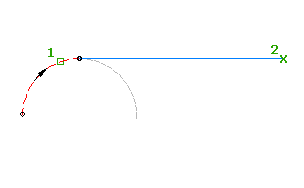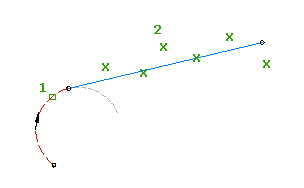Add floating lines to build constraint-based alignment geometry for the areas of your design that require maintaining tangency during edits.
After clicking a button on the Alignment Layout Tools toolbar, follow the command prompts on the command line.
To add a floating line (from curve, through point)
Add a floating line from a point on an existing curve to a specified point. The direction of the attachment curve (1) and the location of the pass-through point (2) determine the attachment point.

- Click the alignment. Click

 Find.
Find. - On the Alignment Layout Tools toolbar, click
 Floating Line (From Curve, Through Point).
Floating Line (From Curve, Through Point). - Select the end of the curve to which you want to add the floating line.
- Specify the end point.
To add a floating line (from curve end, length)
Add a floating line, with a specified length, to the end of a curve
The direction of the attachment curve (1) determines the line direction.

This type of entity always starts at the end of the entity it is attached to. The line is always tangent to the end of a fixed or floating curve. Unlike an entity where the location is defined by a pass-through point, this type of entity is not pinned to a location in the drawing. Therefore, the entity geometry moves with the entity to which it is attached.
- Click the alignment. Click

 Find.
Find. - On the Alignment Layout Tools toolbar, click
 Floating Line (From Curve End, Length).
Floating Line (From Curve End, Length). - Select the end of the curve to which you want to add the floating line.
- Specify a length by picking two points in the drawing, or by entering a length value on the command line.
To create a floating line by best fit from existing entities
Add the most probable floating line from a point on an existing entity through a series of AutoCAD Civil 3D points, AutoCAD points, existing entities, or clicks on screen.
The direction of the attachment curve (1) and the path through the selected regression points (2) determines the location of the attachment point.

- Click the alignment. Click

 Find.
Find. - On the Alignment Layout Tools toolbar, click
 Floating Line - Best Fit.
Floating Line - Best Fit. - Select a curve entity for the start point and direction.
If you select the beginning of the curve entity, the best fit line will precede the curve entity. If you select the end of the curve entity, the best fit line will succeed the curve entity.
- In the Line By Best Fit dialog box, select one of the following:
- From AutoCAD Points. Select one or more AutoCAD points.
- From COGO Points. Select one or more AutoCAD Civil 3D points. Enter G to select a point group or N to enter points by number.
- From Entities. Specify the tessellation and mid-ordinate tolerance settings. Select one or more of the entity types listed on the command line. If you selected a profile object, specify the starting and ending station in the Specify Station Range dialog box.
- By Clicking On The Screen. Select at least one other point. You can use OSNAP or transparent commands to select points.
As you select entities in the drawing window, an X marks each regression point and a temporary, dashed line is displayed in real time. Press Enter to complete the command.
- In the Panorama window, use the Regression Data vista to make changes to the regression points.
As you highlight a row in the Regression Data vista, the corresponding regression point in the drawing window is highlighted in red.
- Create the line:
- Click
 to create the line and keep the Regression Data vista open.
to create the line and keep the Regression Data vista open. - Click
 to create the line and close the Regression Data vista.
to create the line and close the Regression Data vista.
- Click